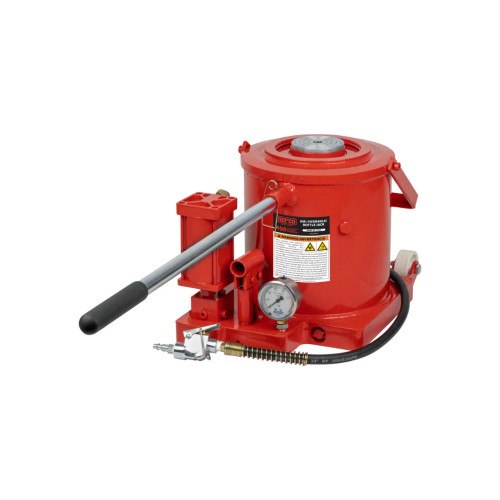In-Depth Comparison: Hydraulic vs. Mechanical Bridge Jacks
Posted by JMC Team on 10th Aug 2023
In 2021, the U.S. Bureau of Labor Statistics (BLS) reported a troubling rise in fatalities among installation, maintenance, and repair workers, with a 20.9 percent increase compared to previous years. Among these tragic incidents, almost one-third of the deaths were attributed to vehicle and mobile equipment mechanics, installers, and repairers.
These alarming statistics underscore the critical importance of workplace safety, particularly in environments where heavy lifting tasks are commonplace. Understanding the key differences between hydraulic and mechanical jacks becomes paramount in these settings as the wrong choice of jack can lead to dire consequences.
This blog delves into the distinctive features of hydraulic vs. mechanical bridge jacks, empowering mechanics and technicians to make informed decisions for their lifting tasks.
The Differences Between Hydraulic and Mechanical Jacks
Hydraulic and mechanical jacks serve as lifting devices but operate using different principles. Here are the key differences between the two:
Characteristics
Hydraulic jacks come in various sizes and shapes, usually resembling a long cylinder with a handle for pumping and a lifting pad or arm at the top. Operating on Pascal’s law, hydraulic jacks utilize pressurized hydraulic fluid, following Pascal's law, evenly transmitting pressure in all directions.
On the other hand, mechanical jacks have diverse designs, but they commonly consist of a solid metal frame with a lifting mechanism and a handle for manual operation. Depending on the specific design, the lifting mechanism can be gears, levers, or a screw. Applying force to the input mechanism multiplies the lifting force, enabling the jack to lift heavy loads easily.
Advantages and disadvantages
Hydraulic jacks generate lifting force through pressurized hydraulic fluid, making them capable of lifting heavier loads with less effort than mechanical jacks. However, hydraulic jacks require periodic maintenance and inspection due to their components such as hydraulic fluid and seals, which, if compromised, can affect performance.
In contrast, mechanical jacks rely solely on mechanical components to generate lifting force, potentially demanding more physical effort to lift heavy loads. Nonetheless, they have simpler mechanisms and may require less frequent maintenance.
Applications of hydraulic jacks

- Garages and Auto Repair Shops: Hydraulic jacks are commonly used to lift vehicles for maintenance and repairs.
- Construction Projects: Used to lift heavy loads like beams, trusses, and precast concrete elements.
- Heavy Machinery and Equipment: For installation, maintenance, and relocation purposes.
- Aviation: Lifting aircraft during maintenance and repair work.
- Warehouses and Distribution Centers: Hydraulic lift systems are used to lift and move heavy goods.
- Mining Industry: Hydraulic jacks are employed for roof support and machinery lifting.
Applications of mechanical jacks:
- Changing Tires: Mechanical jacks, especially scissor jacks, are commonly used for vehicles.
- Foundation Repairs and Structural Installations: Used to lift structures and install beams and supports.
- Factories and Workshops: To lift heavy machinery and equipment.
- Leveling and Adjustment: Providing stability for various structures.
Types of hydraulic and mechanical jacks
Hydraulic Jacks:
- Bottle Jack: Resembling a bottle in shape, these jacks are compact and widely used for automotive applications.
- Floor Jack: Floor jacks are larger and are designed to be placed on the floor, making them suitable for lifting heavier loads.
- Trolley Jack: Trolley jacks come with wheels, offering enhanced mobility and easy positioning.
Mechanical Jacks:
- Scissor Jack: Scissor jacks utilize a mechanical scissor-like mechanism to lift loads.
- Rack and Pinion Jack: This type of mechanical jack uses a gear rack and pinion system for lifting.
- Screw Jack: Screw jacks employ a screw mechanism to raise or lower the lifting platform.
Common Jack Combinations in the Automotive Industry
In the automotive industry, various combinations are often used with other lifting equipment to facilitate different tasks. Some common varieties include:
Airbag jacks and four-post lift
Airbag jacks are sometimes used with a four-post lift in auto shops. This combination is beneficial when accessing specific areas of the car that require fine adjustments.
Rolling jacks and car lift
Rolling jacks are often used with car lifts. They allow mechanics to raise one end of the car at a time, making it easier to work on specific parts.
Choosing the Right Jack for the Job
Here are some steps to help you decide which type of jack is appropriate for your lifting needs:
- Check the weight of the load. Determine the weight of the object or vehicle you need to lift. Hydraulic jacks are generally more suitable for heavier loads, while mechanical jacks are better suited for lighter loads.
- Evaluate lifting efficiency. Hydraulic jacks are generally more efficient for heavy lifting because they generate greater force with less manual effort. A hydraulic jack may be better for tasks requiring repeated lifting to save time and physical exertion.
- Assess safety requirements. Consider the safety implications of the lifting operation. Hydraulic jacks provide excellent stability and support, making them safer for tasks that involve working under a lifted load, such as vehicle repairs.
Revolutionize Your Garage’s Efficiency With JMC Equipment
The main difference between hydraulic and mechanical jacks lies in their operating principles. Hydraulic jacks use pressurized hydraulic fluid to generate lifting force, while mechanical jacks rely on mechanical advantage.
Looking for efficient lifting solutions? As one of America's largest automotive equipment distributors, JMC Automotive Equipment offers various quality hydraulic, mechanical, and specialized jacks from major US manufacturers. Call 800-562-4791 to learn more about our jack selection!

